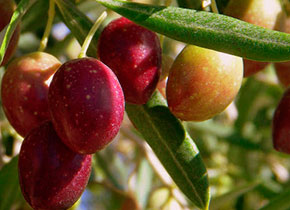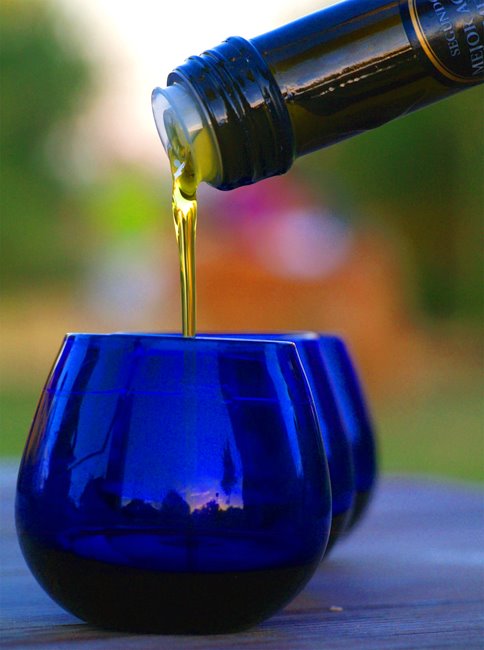Tasting and quality
 Olive oil is a natural product; a real "fruit juice" compared with the vast majority of vegetable oils which are extracted from ground oily seeds and therefore need the help of solvents.
Olive oil is a natural product; a real "fruit juice" compared with the vast majority of vegetable oils which are extracted from ground oily seeds and therefore need the help of solvents.
Quality olive oil is an oily juice obtained from olives in perfect ripe conditions from a healthy olive tree. The oil is obtained from fresh fruit and any handling or treatment that alters the chemical properties of its components must be avoided, both during extraction and storage.
It is important to differentiate between "oil varieties" and "oil quality". Two different olive tree families produce different olive oil varieties, each one with a different colour, aroma and flavour, but both can have the same quality, because quality depends on a combination of factors, such as climate, the type of soil, the care taken during the production process, storage, etc.
An oil's quality is defined by the following criteria, among others:
- Chemical parameters
- Degree of acidity (quantity of fatty acids expressed as oleic acid). This is a result of, among others, the bad condition of the fruit, bad handling or bad storage. The degree of acidity of an oil IS NOT RELATED TO THE FLAVOUR.
- Peroxide index. This determines the initial oxidation of the oil and the deterioration of the natural antioxidants, such as tocopherols and polyphenols, may have suffered.
- Ultraviolet absorbency. This is used to detect any oil's abnormal component
- Sensory analysis
- Organoleptic characteristics(sensations sense organs can detect, mainly related to smell and taste). They are defined by experts by tasting.
Each type of tree, depending on the producing area, has a different variety of fruit and therefore produces an oil with different chemical and organoleptic properties. And within the same variety, different oils are produced depending on factors such as microclimate, the type of soil, altitude...
 Tasting is therefore necessary to appreciate the character and personality of an olive oil. Tasting tells you the characteristic aroma and flavour of each oil. It is important to realise that THE COLOUR DOES NOT REFLECT THE QUALITY, which is why professional tasters use a dark blue glass so that they are not influenced by the colour.
Tasting is therefore necessary to appreciate the character and personality of an olive oil. Tasting tells you the characteristic aroma and flavour of each oil. It is important to realise that THE COLOUR DOES NOT REFLECT THE QUALITY, which is why professional tasters use a dark blue glass so that they are not influenced by the colour.
An olive oil's aroma is appreciated by gently heating the glass and breathing in the fragrances several times to compare them with vegetable aromas (grass, fruit, etc.). As far as flavour is concerned, a few drops are enough to notice the oil's sweetness. An acid flavour is detected towards the centre of the tongue and when the oil is in contact with the palate. Bitterness or a peppery flavour is noticed at the back of the mouth. Tasters normally pour a little oil onto the tip of their tongues and then, by breathing in slowly and continuously, the oil covers the whole palate and then goes back towards the throat.
Among the attributes that can define an oil are, for example:
- Almondy: There can be two types: the typical fresh almond one or the dry healthy almond one. It is appreciated as an aftertaste when the oil stays in contact with the tongue or the palate and it is associated with sweet oils with a mild aroma.
- Bitter: This is a characteristic flavour of oil obtained from green olives: it can be more or less pleasant, depending on its intensity.
- Mild: This is neither a negative nor a positive attribute of an oil whose organoleptic characteristics are very weak, as its aromatic components have been lost.
- Sweet: This is a gentle and pleasant flavour of an oil which is not exactly sugary, but the bitter, astringent or peppery attributes do not predominate.
- Fruity: It reminds us of the aroma and flavour of healthy, fresh fruit picked when it is just ripe.
- Ripe fruit: This recalls olive oil obtained from ripe fruit and generally has a mild aroma and sweet taste.
- Grassy: Aroma and flavour characteristic of some oils that remind us of cut grass.
- Green leaves: Aroma and flavour of oil obtained from over-green olives or which has been ground mixed with leaves and stalks.
- Apple: Aroma and flavour of olive oil that reminds us of apples.
